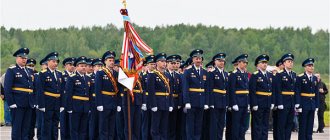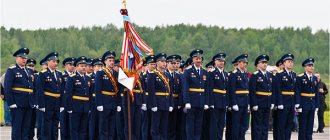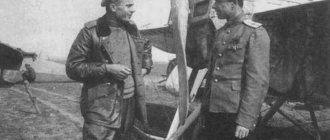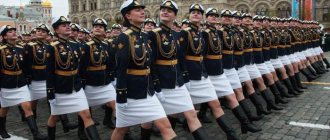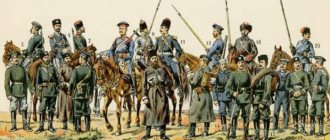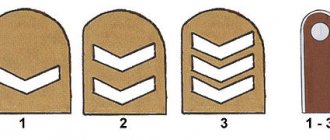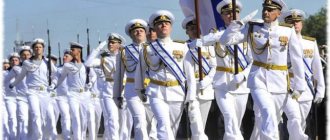By 2005, Russian uniforms were considered outdated and not comfortable for performing both everyday and combat training tasks. "Spotted" camouflage was considered wear-resistant and could withstand heavy loads because it was made of durable fabrics. The technology used to apply the camouflage pattern did not provide good protection for the owner.
When performing daily tasks, the military wore cotton shirts and a wool-blend suit, in which, from early spring to the “Indian summer,” those wearing the uniform felt like visitors to a sauna steam room. Persons serving in the Russian army needed a new uniform to perform tasks of all degrees of complexity.
"Birth" of military aviation
Since the creation of the first aircraft at the turn of the 19th and 20th centuries, the military of all countries paid close attention to the experiments of aviation pioneers. Lighter-than-air aircraft such as balloons and airships, which were widely used during the wars of the second half of the 19th century, have already been tested and shown to be highly effective.
Therefore, as soon as noticeable progress was made in the flight duration and controllability of the aircraft, the military found application for a new type of transport.
The first military aircraft, since 1909, began to be used for surveillance and reconnaissance of enemy positions. The first pilots to use aircraft to attack enemy positions were the Bulgarians during the First Balkan War of 1912-1913, attacking Turkish positions with steel darts and hand bombs. And already by 1915, during the First World War, the history of military aviation opened an account of combat losses suffered by pilots as a result of ground strikes. The “progenitor” of the air defense forces was the Serbian gunner Radoje Lutovac, who shot down an Austro-Hungarian biplane with a captured Turkish cannon.
In just over a hundred years, aviation, and with it the art of flying aircraft, have come a long way. From slow-moving "whatnots" made of wood and fabric that barely reached speeds of 100 km/h and controlled by ropes and pedals, modern military aircraft have reached speeds of MAX 9.1 (more than 9 times the speed of sound), a usage ceiling that allows some fighters ( MIG 25) fly on the border of “near” space - above 37,000 meters. From the use of long-barreled pistols as weapons, with which pilots tried to hit each other when meeting in the sky, and hand grenades, which they threw on the heads of the enemy, modern aviation is armed with the most powerful type of weapon ever created and tested - thermonuclear ( product AN602), known as the “Tsar Bomba” or “Kuzkina Mother”, experiments with which humanity has not dared to repeat since 1961.
The profession of a military pilot is covered with an aura of chivalry, which obsessed the first aces of the First World War, the heroic past of military pilots who participated in two world wars and an innumerable number of smaller local wars. During the Soviet era, two of the three three times Heroes of the Soviet Union were fighter pilots. Military pilots hold the palm in the exploration of outer space and (hypothetical) exploration of extraterrestrial space (landing on the moon???).
Despite the fact that the halo of heroism that surrounded military pilots in the “Golden Age” of aviation - the period between the two world wars - has faded, there are many dreamers who have been striving for the sky since childhood. Those who cannot imagine life without exorbitant speeds and every minute risk.
New collar buttonholes for office uniforms were introduced into the military this year
Today we will talk about new “coil” buttonholes for military officers.
As reported by a number of publications, the Ministry of Defense of the Russian Federation has already developed and plans to introduce in the near future new lapel emblems that resemble the insignia of the Russian Guard of the 19th century. This buttonhole among the officers received an unspoken name - “reel”
Read about whether there will be an increase in the length of service bonus for military personnel in 2022
and what salaries await us for military personnel in 2022!
The new buttonholes will be located on the corners of the collars of jackets, casual suits (office uniforms) and casual shirts, and these insignia will be introduced exclusively for officers of the RF Armed Forces.
How to correctly place buttonholes on officers' office uniforms
Buttonholes for officers - a sign of belonging to the officer corps
For officers (except for senior officers and officers of the Navy) in the form of a historical golden buttonhole on protective cloth - for officers of the Ground Forces, and for officers of the Air Force, Aerospace Forces and Airborne Forces - blue.
Placement and wearing of buttonholes on office uniforms
The buttonholes are placed on the “office” in pairs on the lower part and along the edge of the collar of the office uniform. Parallel to the line of departure and cut of the collar. You also need to remember that the color of the threads must match the color of the cloth of the buttonhole.
This is what the new buttonholes for officers' office uniforms look like
The overall size of the buttonhole is 22 by 32 mm. Along the entire perimeter of the buttonhole, at a distance of 2 mm from the edge, there are edgings of a protective color (blue for the Air Force, VKS and Airborne Forces).
Edge width - 1mm. The height of the historical buttonhole is 24 mm.
The width of the historical buttonhole at its widest point is 16 mm, at its narrowest point - 8.5 mm.
New collar tabs for Navy officers' office uniforms
For officers of the Navy (except for senior officers of the Navy) - in the form of golden anchors.
Overall size 31 by 37 mm. There are black edgings along the perimeter of the buttonhole at a distance of 2 mm from the edge.
Edge width - 1mm. Anchor height - 34 mm. Width - 22 mm.
Coil buttonholes on office uniform
How and where exactly these coil buttonholes will be worn on the uniform will be announced later.
Since work has currently been organized to amend the Order of the Minister of Defense of the Russian Federation dated June 22, 2015 No. 300 “On approval of the rules for wearing military uniforms, insignia, departmental insignia and other heraldic signs in the Armed Forces of the Russian Federation and the Mixing Order items of existing and new military uniforms in the Armed Forces of the Russian Federation"
And we must assume that in the near future all officers of the Russian Army will wear new-style buttonholes on their office uniforms.
Russian Aerospace Forces uniform
The uniform of the Russian Aerospace Forces troops has much in common with the traditional uniform of the Air Force. Despite this, the form of videoconferencing also has some differences that are unique to it. For example, the VKS chevron has its own original image. The patch represents a double-headed eagle with a cannon and a propeller in its claws, against the background of the Russian flag.
The VKS uniform is distinguished by a special emblem, which comes in three types:
Small emblem;Medium;Large.
The large emblem is a coat of arms that has elements of the small and medium emblem.
The shape of the VKS differs and it has special buttonholes. Before this, only the Suvorov uniform had such insignia. Aerospace Forces pilots traditionally wear blue uniforms.
The VKS flag is a stylized emblem on a blue background. Despite its youth, the VKS flag already has its own history. The first flag of the Aerospace Forces had the inscription “Military Space Forces”, which was located above the emblem. The new VKS flag has lost this inscription.
Read with this
Ceremonial costumes
The uniform of military pilots for taking part in various parades makes it possible to form a positive image of a modern military man among ordinary people. This point was clearly taken into account in the process of creating new flight equipment. Dressed in full dress, pilots look impressive and stern, they actually look more courageous.
The ceremonial uniform of the cadets will differ from the equipment for every day in a special cut and the presence of more decor. In order to sew it, they choose the best quality materials, most often 100% wool. The shirt of an ordinary pilot, as a rule, is of a special khaki color, but the jacket and trousers must be blue.
In winter, student pilots wear special coats, warm mufflers, and black comfortable gloves made of genuine leather for the ceremonial parade. Depending on the weather, they may wear hats with earflaps, as well as caps or berets.
Dress uniform
The uniform for participation in parades helps to form a positive image of a military man among purely civilian sections of society. This point was undoubtedly taken into account when creating new uniforms. Formally dressed military personnel look impressive, courageous, and beautiful.
Uniforms for cadets and enlisted personnel
Dress uniform differs from everyday uniform in cut and decoration. To sew it, we use the best quality fabrics, including natural wool. A soldier's shirt must have a khaki color, but his jacket and trousers can be blue.
Dress uniform of the Russian Air Force - photo of a cadet of the Voronezh Air Force Training Center taking the oath.
In winter, privates and cadets go to the parade in uniform coats, mufflers, and black gloves. Depending on weather conditions, their heads are covered with earflaps, berets, and caps.
Officer uniform
The ceremonial uniform of Air Force officers consists of trousers and a sea green jacket. White shirts and black ties held with paper clips are in harmony with the uniform. The warrior's image is completed with a cap and a waist belt with a golden tint. Boots must comply with the requirements of the Charter.
New summer dress uniform for the Air Force officers of the Russian Aerospace Forces
In winter, regulations require the wearing of black or white gloves. Outerwear consists of a gray hat, a white muffler, and a blue coat. The color of the belt is similar to the summer accessory of ceremonial outfit.
Uniform of female military personnel
The summer version of the dress uniform for women is practically no different from the office uniform. The exception is golden or black waist belts, which must be worn by privates and officers, respectively.
The ceremonial winter uniform of the Russian Air Force for women is slightly different from the everyday suit; it is limited to the color of the muffler. The scarf must be white.
Russian Air Force uniform after Sergei Shoigu's reform
According to Shoigu's reform, the Ministry of Defense of the Russian Federation introduced a new standard for uniforms. In addition to the military uniform, office uniforms were developed for department employees. All office uniforms must be the same for both military and civilian employees. The entire uniform is produced in three colors:
- Blue;
- Black;
- Protective.
By the color of the uniform, you can determine which branch of the military the department employee belongs to.
The officer's casual summer uniform consists of the following elements:
- Blue jacket;
- Blue trousers;
- Blue shirt;
- A black tie must be worn with a gold clip;
- Blue or khaki cap;
- Black boots or ankle boots;
- Black belt.
In addition, the charter does not prohibit the wearing of various caps, berets and caps. In this case, there is only one mandatory condition - they must be blue or khaki. You can also wear raincoats and jackets of the same colors.
The dress uniform of Air Force officers these days is the most different from the uniform of other troops, so it is worth considering it in more detail:
- The summer uniform consists of a sea green tunic and trousers, a white shirt with a black tie, and a gold stud. Caps, whose color should match the color of the uniform. Black boots and a golden belt, which is worn during formations;
- The winter officer's uniform is necessarily complemented by a blue or gray coat, a white muffler and gloves, which can be either white or black.
The dress uniform of generals and marshals differs from the officers' uniform by the presence of a collar and a hat. These clothing items are made only in gray. Astrakhan fur is used for their production.
Air Force uniform in the USSR
In 1922, Order No. 322 was issued, regulating the wearing of casual and dress, combat and non-combatant uniforms for all types of troops of the newly formed Red Army. This order provided for aviators to wear two types of uniforms. The same order spoke about the organizational and staffing component of the troops and their division into forty branches, with each element of the structure assigned an individual emblem. The Air Force also had two emblems designated.
In 1924, aviators changed the color of their uniforms from black to blue.
And although the cut of the uniform was no different from the uniform of the Ground Forces, the Soviet command decided to introduce additional color differences.
So, pilots began to wear trousers and riding breeches with blue piping. The edging of the buttonholes also became blue. In the same year, the pilots' wardrobe was replenished with an overcoat, a new-cut tunic and a summer tunic. The first was worn by the military in the winter, after the official order to switch to an insulated version.
The jacket was worn wherever staff work was carried out. A blue cap with a Red Army star in the middle on its rim above the visor was worn with this uniform. At that time, gymnasts were well suited for working on equipment; it was comfortable to carry out combat and combat training missions in them.
As aviation technology developed, the need for high-quality maintenance arose. At first, the pilots themselves repaired and prepared the planes for takeoff. But later, aircraft mechanisms became more complex. Pilots could no longer maintain aircraft and perform in-flight tasks at the same time because it took too much time. This is how another detachment appeared - a technical one, which was responsible for bringing the equipment ready for flight.
To distinguish the technicians from other units, the personnel sewed a distinctive sign onto the sleeve of their uniform - the crosshairs of a wrench and a hammer in golden tones.
In 1925, last year's innovations were canceled by a new reform, which introduced new elements into the wardrobe of Air Force personnel.
Now it included:
- a jacket with three buttons, a style of cut that was borrowed from the British;
- field tunic;
- shirt with tie;
- cap;
- flight helmet;
- boots;
- breeches;
- overcoat;
- gray breeches;
- boots.
The piping on the aviators changed color - it became black, the buttonholes still remained blue. The following year, another reform replaced the wearing of gray breeches with dark blue ones. And she added a white shirt and a dark blue jacket to the full set of aviator uniforms.
In 1935, a global reform took place, and this time, big changes awaited the aviators' uniform. The shoulder straps were removed, and the insignia of the ranks of the personnel - diamonds, sleepers and red triangles - were attached to the blue buttonholes of the tunics. They also introduced two types of chevrons intended for command personnel at various levels. The complete uniform looked like this:
- Jacket with 4 buttons and a cutout on the chest.
- The cap was blue with a blue star embroidered on the front, into which a red star-cockade with a hammer and sickle cross was inserted.
- Summer helmet and winter helmet. In both versions, a metal star was attached to the front.
- Trousers and breeches in dark blue tones with blue piping.
- Summer and winter field tunics with a waist belt with a star-shaped badge. Wearing uniforms without a belt was considered a violation of drill regulations.
- Winter overcoat blue.
- Leather jacket and flight suit.
- Officer's cap. What was new was the use of the Air Force insignia in the form of spread ribbed wings and a star in the middle between them. The sign was attached to the rise of the cap, 5 cm above the cockade.
During the Great Patriotic War, the red color of the officer corps insignia was replaced by field olive. And with the later addition of shoulder straps to military uniforms, the gaps became blue. Clearance is a stripe embroidered along the shoulder strap, which determines which officer corps the soldier belongs to.
Air Force uniform 1935
One gap is junior officers from junior lieutenant to captain. Shoulder straps with two stripes were worn by officers belonging to the senior officer ranks from major to colonel.
After the end of the war, in 1949, a uniform was introduced for the command staff of aviators, which differed from the previous uniform in appearance. The new uniform was more comfortable to wear and perform daily tasks.
The blue jacket was replaced by an olive jacket of a new cut, to which shoulder straps with gaps were returned, with three buttons with the coat of arms of the Soviet Union. The trousers remained with the same blue piping. The mandatory wearing of a dagger with the dress uniform was added. Another post-war innovation was the general's stripes - two wide stripes along the edge, one on each side of it.
In 1969, another reform occurred, which increased the superiority of the Air Force over other types of troops in the field of uniforms.
The reform changes primarily affected the ceremonial wardrobe of the flight personnel and the units ensuring the organization of flights.
The new general uniform included:
- a blue cap with an officer's cockade and a blue headband;
- a white shirt, with which it became mandatory to wear a black tie;
- officer's shoes;
- a blue jacket, on which wearing all awards was considered mandatory;
- White gloves;
- gold-colored ceremonial belt with the symbols of the Soviet Union on an oval plaque;
- brown leather winter gloves;
- blue trousers with blue stripes;
- white muffler and hat;
- an overcoat that changed from blue to a steel shade;
- summer tunic of the ceremonial type in light colors.
In terms of cut, the clothing of junior and senior officers differed little from the general's uniform. The difference was in the quality of execution, individual colors and the list of required uniforms. Thus, officers up to the general level were not allowed to wear trousers with stripes or a hat.
This form of clothing remained until 1992. After the collapse of the Soviet Union, both officers and generals changed into a protective dark olive color. The blue edging on the buttonholes has been removed. The difference between the branches of the military was the chevrons with images of the coats of arms of the specific occupation of the military, as well as the piping on the trousers. The rises of the caps increased, along with their circumference. The bands of the hats also became a dark olive color.
Names
- Central Directorate of Space Facilities (TSUKOS) of the Strategic Missile Forces (Strategic Missile Forces) (1964-1970)
- Main Directorate of Space Facilities (GUKOS) of the Strategic Missile Forces (Strategic Missile Forces) (1970-1981)
- Main Directorate of Space Facilities (GUKOS) of the General Staff of the Armed Forces of the USSR (1981-1986)
- Office of the Chief of Space Facilities (UNKS) of the USSR Ministry of Defense (1986-1992)
- Military Space Forces (VKS) (1992-1997)
- Military units and institutions for launching and controlling spacecraft of the Strategic Missile Forces (Strategic Missile Forces) (1997-2001)
- Space Force (SF) (2001–2011)
- Space Command (SC) of the Aerospace Defense Forces (VVKO) (from December 1, 2011 - August 1, 2015)
- Space Forces (HF) Aerospace Forces (since August 1, 2015)
Air Force uniform for today
Uniforms for cadets and enlisted personnel
The summer version of the office uniform consists of a blue suit, a white T-shirt, a field cap, black high-top boots, black socks and a field cap. The winter version of the office uniform consists of a camouflage suit and T-shirt (T-shirt), a muffler and protective coat, a camouflage field cap, black boots or low shoes with black socks and camouflage gloves. In service, the uniform is completed with a black belt. Stripes on summer military uniforms are always placed on the left sleeve, on the outside. Stripes should only be placed on the jacket or coat.
Officer's uniform
The summer casual uniform consists of a blue jacket and trousers, and a blue shirt. Under the shirt goes a black tie with the obligatory gold tack. A blue or protective cap serves as a headdress. Shoes are required in black boots, low shoes or ankle boots with black socks. The uniform for the form is equipped with a black belt.
In winter, the uniform of Air Force officers consists of trousers and a blue or khaki jacket. Under the suit, a khaki or blue shirt with a black tie and gold pin is required. The outerwear is a gray or blue coat with a gray hat with earflaps. Gloves must be black. Under the coat - a protective or blue muffler. Shoes – low shoes, shoes or boots with black socks. The uniform for the formation is complemented by a black belt.
The charter allows the wearing of caps, caps or berets, raincoats and jackets in khaki or blue. In the winter version of the uniform, instead of a jacket, you can wear a blue or khaki sweater.
Senior officers uniform
The main difference between the winter uniform of senior officers is the presence of a gray astrakhan detachable collar and a gray hat.
Uniform of military personnel - women
The summer casual uniform of female military personnel consists of a skirt and jacket in blue or khaki, a blouse in khaki or blue, and a tie with a gold tack. As a headdress - a blue or protective cap. Shoes – shoes or boots of black or flesh color.
The winter office uniform is complemented by a khaki or blue muffler and a khaki coat. Headdress – gray astrakhan beret. The coat colors of officers and warrant officers are blue and gray.
Modern casual uniform of Russian Air Force military personnel
The blue aviator uniform for everyday wear is comfortable and practical. It is sewn from durable fabrics with water-repellent and antistatic properties. The jackets and trousers wrinkle a little, are easy to wash, and are ironed well.
Uniforms of privates and cadets
The uniform set for cadets and soldiers includes: blue military uniform, lace-up high boots, suits, white T-shirts, black socks, and a field version of the cap. The winter version of the equipment consists of a camouflage jacket, trousers, a T-shirt, a coat and a khaki muffler, an insulated hat, and gloves. This pilot's uniform is worn with a black belt.
Cadets of the Voronezh Air Force Academy on the parade ground in field uniform.
Officer's uniform
Air Force officers dress in blue shirts, blue trousers and jackets in the summer. Caps are used as headdress. The drill regulations require commanders to wear black boots. The Air Force uniform is worn with a tie, secured with a gold-plated bartack depicting the emblem of the branch of service.
Variant of the daily uniform for VKS officers
In winter, it is allowed to wear a khaki shirt, jacket, and trousers. Outerwear is represented by coats - blue or gray, matching the color of the hat with earflaps, gloves, and mufflers. On warm days, it is not forbidden to dress in green or blue sweaters, wear uniform jackets, raincoats, caps, caps.
Senior Officers' Uniform
According to their rank, senior officers are required to wear a coat or jacket with an astrakhan collar and a hat. Otherwise, the uniform of the highest ranks of the army hierarchy does not differ from the equipment of colleagues of lower rank and service status.
Variants of the daily uniform of the generals of the Russian Aerospace Forces.
Uniforms of female military personnel
The summer outfit of the defenders of the Motherland consists of black or light beige low-heeled shoes or boots, a white blouse, a blue jacket, skirt, and trousers. Women wear ties, classic or shortened, and caps.
Options for everyday equipment for women serving in the Aerospace Forces.
In winter, the equipment is complemented by a coat with an astrakhan collar and a fur beret. Ladies are not prohibited from wearing short or high boots of the authorized color. The waist belt is an integral uniform accessory.
Air Force uniform for today
Uniforms for cadets and enlisted personnel
The summer version of the office uniform consists of a blue suit, a white T-shirt, a field cap, black high-top boots, black socks and a field cap. The winter version of the office uniform consists of a camouflage suit and T-shirt (T-shirt), a muffler and protective coat, a camouflage field cap, black boots or low shoes with black socks and camouflage gloves. In service, the uniform is completed with a black belt. Stripes on summer military uniforms are always placed on the left sleeve, on the outside. Stripes should only be placed on the jacket or coat.
Officer's uniform
The summer casual uniform consists of a blue jacket and trousers, and a blue shirt. Under the shirt goes a black tie with the obligatory gold tack. A blue or protective cap serves as a headdress. Shoes are required in black boots, low shoes or ankle boots with black socks. The uniform for the form is equipped with a black belt.
In winter, the uniform of Air Force officers consists of trousers and a blue or khaki jacket. Under the suit, a khaki or blue shirt with a black tie and gold pin is required. The outerwear is a gray or blue coat with a gray hat with earflaps. Gloves must be black. Under the coat - a protective or blue muffler. Shoes – low shoes, shoes or boots with black socks. The uniform for the formation is complemented by a black belt.
The charter allows the wearing of caps, caps or berets, raincoats and jackets in khaki or blue. In the winter version of the uniform, instead of a jacket, you can wear a blue or khaki sweater.
Senior officers uniform
The main difference between the winter uniform of senior officers is the presence of a gray astrakhan detachable collar and a gray hat.
Uniform of military personnel - women
The summer casual uniform of female military personnel consists of a skirt and jacket in blue or khaki, a blouse in khaki or blue, and a tie with a gold tack. As a headdress - a blue or protective cap. Shoes – shoes or boots of black or flesh color.
The winter office uniform is complemented by a khaki or blue muffler and a khaki coat. Headdress – gray astrakhan beret. The coat colors of officers and warrant officers are blue and gray.
Uniforms of the Air Force of the Russian Empire
Old and new airborne uniforms: demobilization and ceremonial
1914
this year special uniforms for aviators were introduced
Russian military aviation dates back to 1910. Then, the first aircraft appeared in some engineering units. There was no separate equipment for pilots. They wore slightly modified infantry uniforms made of black cloth. Special uniforms for aviators were introduced in 1914.
Military uniform of the Russian Air Force, photo of the 1914 model.
The daily uniform of the Air Force consisted of a jacket and light brown riding breeches. Pilots went on combat missions in winter wearing leather jackets with a fur collar.
There were two types of uniforms - ceremonial and non-combatant.
In different cases, the headgear was a cap, a cap - a lightweight replica of a dragoon cap, and a leather helmet. Officers were required to wear a saber with their ceremonial uniform.
Helmet of a Russian military aviator.
Uniforms of Red Army pilots from 1935 to 1943
By 1935, most of the military personnel who served in the Civil War had either retired or achieved significant military positions. In the memory of the younger generation there was no acute rejection of senior military leaders as representatives of the ruling class. The mistakes of the abolition of military ranks in the Red Army were realized.
In 1935, military reform was carried out and military ranks for the command staff of the Red Army were partially restored. The first 5 marshals appeared. The most junior officer rank was junior lieutenant. Differences in military ranks and positions were indicated by insignia worn on buttonholes (epaulettes were still hated) and sleeve patches.
By 1935, Soviet aviation occupied a leading position. Aircraft capable of intercontinental flights were created. The prestige of a military pilot was at the highest level in the entire history of the Air Force.
The developers of the new uniform for the air force did not skimp on the variety of sets of clothing and its styles (design). The range of clothing sets for officers and enlisted personnel was expanded. Significant differences appeared in the cut, quality of materials and terms of wearing. Wearing shoes was ranked:
- chrome boots - for all officers;
- yuft ones - for petty officers and non-commissioned officers (command personnel - in the terminology of the Red Army);
- cowhide or tarpaulin - for privates.
Officer's uniform of the 1935-1941 model. included two sets.
Summer set:
- Double-breasted overcoat (lightweight cloth);
- Cap or cap;
- Summer tunic (military field);
- Cotton or cloth breeches for tuning;
- French ceremonial weekend;
- Trousers for formal-weekend graduation;
- White shirt;
- The tie is black;
- The gloves are white;
- Chrome boots or boots with leggings;
- Boots are black or brown for dress uniforms.
Figure 3
Summer ceremonial and weekend set
Winter set:
- Double-breasted overcoat black and white;
- Cloth helmet (Budenovka type);
- French p/sh;
- Tunic, p/sh;
- Breeches-breeches p/sh;
- Chrome boots or insulated boots (with leggings);
- Gloves (brown).
Figure 4
Winter set
In addition to summer and winter uniforms, military pilots and crew members (flight personnel) were equipped with special clothing: long leather coats with fur, leather helmets with fur, high boots, leggings, fur gloves, flight jackets (with a detachable fur lining), various types of underwear linen made of pure wool, polyester and cotton fabric.
The pilots had silk scarves as part of their flight uniform. This is not foppishness, but a practical necessity. During air combat, the pilot had to turn his head hundreds of times. Any fabric other than silk would chafe the neck and incapacitate the pilot. Therefore, a silk scarf was a distinctive feature of a military pilot (not only in the Red Army, but also in the armies of other countries).
Particular attention was paid to the insignia of senior, senior, middle and junior command personnel. Only the color of the buttonholes and edging remained unchanged - blue:. Figure 5
Figure 5
Insignia of the senior command staff of the Air Force Red Army 1935-1943.
Figure 6
Insignia of senior command staff of the Air Force Red Army 1935-1943.
Figure 7
Insignia of junior command staff of the Air Force Red Army 1935-1943. and privates
“Military uniform of the VKS” in the post-war period
The years of the Great Patriotic War raised the authority of military pilots to unattainable heights. The largest number of twice Heroes of the Soviet Union and two three times heroes awarded this title for personal courage and military merit are military pilots. Aviation also had its own marshals: A.A. Novikov - commander of front-line aviation and A.E. Golovanov is the commander of the ADD (later, both were awarded the title of Chief Marshal of Aviation of the USSR). There was a need to improve the military uniform of military pilots. Bringing it into line with the combined arms uniform.
In the period from 1947 to 1969 it was not particularly diverse. The traditional dark blue color of the uniform of military pilots was replaced by a combined arms - protective one. The color of buttonholes, cap bands, stripes and gaps on shoulder straps remained unchanged.
After 1969, the cut of the uniforms was changed. Instead of a stand-up collar, a double-breasted cut of the tunic began to be used, and soldiers and petty officers received turn-down collars in cotton and woven fabric, as well as a ceremonial dress uniform made of woven fabric.
Uniform of pilots of the Russian Imperial Army (RIA)
The history of the air force of Tsarist Russia dates back only 7 years. The separate detachments of aeronauts that existed before 1910, taking to the air in balloons and airships (and even kites!!!), were not considered a separate branch of the military and were used exclusively for reconnaissance and observation purposes, fire adjustment, and early warning of the approach of the enemy.
The organizer and first head of the air force of the Russian Empire was the uncle of Emperor Nicholas II, Grand Duke Alexander Mikhailovich. It was on his initiative (with private donations from the grand ducal family and Russian philanthropists and industrialists) that on January 30, 1910, the Empire's air fleet began to be created. Russian aeronauts L. Matsievich, S. Ulyanin, G. Piotrovsky, B. Matyevich-Matsevich, M. Zelensky and M. Komarov were sent to France to study the capabilities of aircraft and learn to fly. At the same time, a group of 6 lower ranks (non-commissioned officers) were sent to train in the technical side of maintenance and operation of aircraft, who were to become the first aviation technicians and begin training personnel after their return.
These 12 servicemen did not have a single military uniform that would indicate their belonging to a new branch of the military. Officers were recruited entirely on a voluntary basis. Basically, these were naval officers and middle ranks of the engineering corps. Therefore, the uniform of the first military pilots was black. Since both naval officers and military engineers wore black uniforms with gold or silver buttons.
Already on August 12, 1912, the aeronautical units were removed from the subordination of the engineering department and reassigned to a specially created body, essentially the Main Command of the new type of troops - the Aeronautical Unit of the General Staff of the RIA. Major General M.I. Shishkevich was appointed commander of the new branch of the army. From that moment on, military pilots had their own uniform.
Despite the fact that the participation of military aviation in the First World War was quite active, and the Russian Empire, the first in the world, used the Ilya Muromets heavy bombers in battles, the RIA air fleet, in comparison with other branches of the military, was extremely small. The formation of the uniform worn by the first military pilots was influenced by two factors:
- The peak of development of military aviation occurred during the war years. Traditionally, the uniform of the Russian army was created according to Prussian models (since the time of Peter I). But, since the Russian Empire was at war with the German Empire, the Russian Tsar (99% German) was an ardent Russian nationalist, he wished that all similarities in form with the German one would be abolished.
- The English and partly French form was taken as a model.
Military pilots during the First World War wore brown English-style jackets and breeches of the same color. Since the war was going on, the field uniform was almost no different from the ceremonial uniform. A distinctive feature of the flight uniform was leather jackets, leather trousers, elongated leather coats insulated with fur, leggings worn on the legs and arms, a leather helmet with fur and “canned” glasses.
Military pilots were almost indistinguishable in their uniform from scooter riders, armored car drivers, motorcyclists and motorists. Practical and non-staining black leather clothing was popular among all representatives of the “technical” troops, which perfectly protected against moisture and cold, was easy to clean and resistant to mechanical damage.
PICTURE 1
RIA pilots in field and flight leather uniforms
Reform of Sergei Shoigu
Almost twenty years have passed since the beginning of Perestroika, the renewed Russian army has been equipped with uniforms developed back in the USSR. In 2007, A.E. Serdyukov, a purely civilian man, was appointed Minister of Defense.
The five years during which he led the department did not bring anything good to the army. Civilian officials who occupied leading positions in the ministry were remembered for their exorbitant greed and undertakings in the style of the unforgettable Baron Munchausen.
Such projects include the allocation of a 170 million tranche to clothing designer V. Yudashkin to create samples of new uniforms for the Armed Forces.
A.E. Serdyukov and V. Yudashkin present samples of new uniforms to the President of Russia.
The fashion designer successfully failed the military mission. In fact, it turned out that the uniform from the famous couturier did not help in any way to endure the hardships of military service, and the price of the sets turned out to be exorbitant. The new Russian Air Force uniform was elegant, but unsuitable for field conditions. Beautiful overcoats, for example, did not warm at all in the cold.
The situation changed in 2012, when the post of the dismissed Serdyukov was taken by the former head of the Ministry of Emergency Situations S.K. Shoigu.
2012
this year S.K. became the Minister of Defense of the Russian Federation. Shoigu
The reforms he initiated affected the entire life of the army - from the organizational and legal sphere to the everyday life of military personnel. Soon the troops received sets of modern uniforms.
The current uniform of a military aviation pilot is unified. Not only buttonholes or chevrons indicate that a soldier or officer belongs to a particular branch of the military, but also the color of the jacket: protective, black, blue. The cut is the same in all cases. The only difference in silhouette from the base model is the uniform of sailors and the camouflage of special forces military personnel.
Military uniform of the Russian Air Force of a new model.
Military personnel of the Aerospace Forces, like other branches of the military, are equipped with three types of uniforms.
The military uniform of the Russian Air Force can be:
- Field. The main type of uniform for privates, sergeants, and officers, intended for daily wear in any conditions;
- Front door. Worn to participate in ceremonial events, drill reviews by order of the commander;
- Office. The uniform of Russian pilots has been included in the list of uniforms for officers, generals, and civilian employees of the Defense Ministry.
Air Force uniform from Yudashkin
In 2007, the former head of the Federal Tax Service, E. A. Serdyukov, was appointed to the post of Minister of Defense. On his initiative, the government is allocating 170 million rubles this year for a large-scale reform of military uniforms. The task was entrusted to a fashion designer with the demeanor of a person with a non-traditional sexual orientation - Valentin Yudashkin.
Research in this area was conducted for two years and in mid-2009 the form was gradually introduced into circulation.
But as practice has shown, it only got worse. Camouflage with an epaulette on the chest looked unnatural and made it difficult to complete certain tasks. The insulated field jacket did not cope with the task of protecting the soldier from the cold; after 5-7 minutes of being outside at a temperature of -15⁰C below zero, his arms from the shoulder and upper back froze.
Old-style overcoats with a cutout on the chest with 3 buttons have been replaced by fitted overcoats with 4 buttons. At the same time, the new type of overcoat also left the arms and back vulnerable to the cold.
In terms of wear resistance, the new uniform was many times inferior to the old one, failing military personnel at the wrong time. Among the advantages, it is worth noting only the camouflage “pixel” coloring, which copes better with the task of camouflage in field conditions. But it couldn’t be called new, since the Americans switched to a similar coloring back in the late 90s of the last century.
As for the ceremonial uniform, there was also confusion here. The colors of the military branches were returned to the dress uniform. But this was done incorrectly, and together with the Air Force, paratroopers and special forces troops wore dark blue dress uniforms.
Both formal and everyday jackets with three buttons depicting the coat of arms of the Russian Federation were sewn in at the waist.
The tailoring of the trousers remained unchanged, with the exception of the absence of piping, which further depersonalized the military branches. The 2009 reform is considered a failure in the Air Force, and military personnel remember it with indignation.
